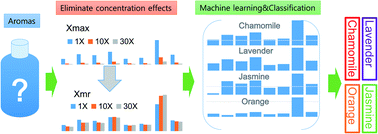Identification of multi-concentration aromatic fragrances with electronic nose technology using a support vector machine†
Abstract
Due to the concentration effect, there is a major challenge for the electronic nose system to identify different odor samples with multiple concentrations. The development of artificial intelligence provides new ways to solve such problems. This article attempts to use support vector machine (SVM) technology to distinguish four fragrance samples with three concentrations, including roman chamomile, jasmine, lavender, and orange. The responses of these samples were collected by an 11-sensor electronic nose. After baseline correction, data smoothing, and removal of non-responsive sensors, the signals of 8 sensors were used for subsequent model analysis. Due to the concentration effect, when the primary signal intensities were used as features, the electronic nose cannot distinguish between different aroma types (accuracy less than 50%). When the normalized maximum signal intensity Xmr was used, the accuracy of the model was greatly improved. Graphic analysis and PCA showed that the normalized feature effectively eliminates the concentration effect, and appropriately reducing some sensors can enhance the ability to distinguish odors. The SVM correctly classified all 14 aromas when feeding 8 sets of data to train the radial kernel C-classification SVM. This showed that the cross-interference of the sensors was reduced, and the resolving power of the electronic nose was enhanced after the feature reduction.



 Please wait while we load your content...
Please wait while we load your content...